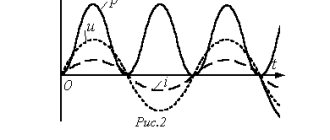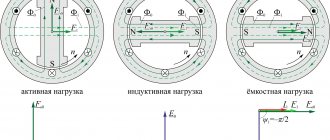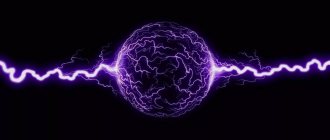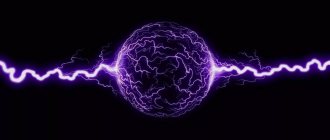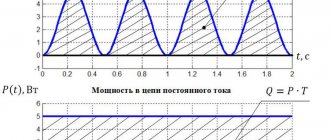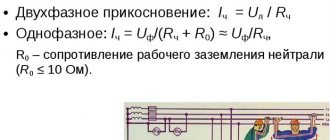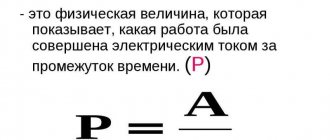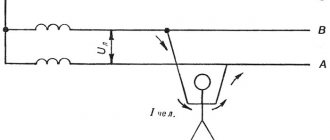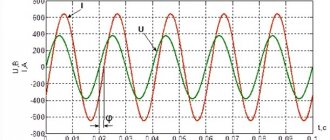- home
- Directory
- Physics
In order to characterize the speed at which work is performed ($A$), the concept of power (P) is used, which is defined as:
\[P=\frac{dA}{dt}\left(1\right),\]
expression (1) is the instantaneous power.
Instantaneous power can be defined as:
\[P=\overline{F}\overline{v}\left(2\right),\]
where $\overline{F}$ is the vector of the force that does the work; $\overline{v}$ is the velocity vector of the point to which the force $\overline{F}$ is applied.
Watt - SI unit of power
From the definition of power it is clear that the unit of measurement for power can be taken as follows:
\[\left[P\right]=\frac{J}{s}.\]
However, the unit of power has its own name: watt is a unit of power. Watt is denoted as W. Power is equal to 1 W if work equal to one joule is performed in one second. It should be noted that a watt is a unit of power in the International System of Units (SI). The watt is not a basic SI unit of measurement. Watt received its name in honor of the inventor J. Watt.
The watt as a unit of power measurement began to be used after 1882. Up to this point, power was calculated in horsepower or foot-pounds per minute. In the SI system, the watt has been a unit of measurement of power since 1960 (since the adoption of the system itself).
Using the definition of instantaneous power (2), it is easy to obtain the combination of basic units that make up the watt.
\[\left[P\right]=Н\cdot \frac{m}{s}=kg\cdot \frac{m}{s^2}\cdot \frac{m}{s}=kg\cdot \ frac{m^2}{s^3}.\]
Definitions (1) and (2) are mechanical definitions of power. Let us also highlight the instantaneous electrical power:
\[P=UI\ \left(3\right),\]
where $I$ is the current strength in a certain section of the circuit; $U$ is the voltage in the area under consideration. Watt is a unit of measurement of electrical power, and from definition (3), it follows that:
\[\left[P\right]=A\cdot B,\]
where $\left[I\right]=A$ (amps); $\left[U\right]=B$ (volts).
Power determination
The speed of work is characterized by a physical quantity called power.
Power is a physical quantity equal to the ratio of work to the time during which it was performed.
To calculate power, you need to divide the work by the time during which this work was done:
$$power = \frac{work}{time}$$
or
$$N = \frac{A}{t}$$
where $N$ is power, $A$ is work, $t$ is the time it takes to complete the work.
Power can be:
- Constant if the same work is done every second
- Non-constant if different work is done every second. In this case, we talk about average power: $N_{avg} = \frac{A}{t}$
Power units in other unit systems
In the GHS system (a system in which the main units are: centimeter, gram and second), the unit of measurement of power does not have a special name. In this system:
\[\left[P\right]=\frac{erg}{s},\]
where $erg$ is the unit of measurement of energy (work) in the CGS.
\[1\ W={10}^7\frac{erg}{s}.\]
Horsepower (hp) is a non-system unit of measurement of power. There are several different units around the world called “horsepower”. In our country we mean “metric horsepower”, they consider:
\[1W\approx 1.36\cdot {10}^{-3}hp\] \[1\hp=735.49875\W\]
This unit has practically been withdrawn from use in calculations. However, it is still used, for example, in calculating vehicle taxes.
Formula for the relationship between power, voltage and current
To derive dependencies between the parameters under consideration, you can return to the definition with work. In this case, the movement of charge (Q) over a given distance is considered. When moving from point F1 to F2, work (A) will be performed equal to the change in potential or voltage. The basic formula is easy to transform:
P=A/t = (U/t)*Q.
The current strength is determined by the amount of charge that moves during the control time (I = Q/t). After combining the marked dependencies, the following result will be obtained:
P = U * I.
“Related” parameters have been removed from this expression. Typical electrical quantities are left. If we add the well-known formula of Ohm's law, we can establish working relationships for calculations taking into account electrical resistance:
P = U2/ R = I2 * R.
Basic formulas for calculation
For your information. The presented dependencies allow you to obtain accurate calculation results when working with a direct current source. However, in a standard household network, single-phase 220 V power is used. The signal amplitude changes with a normalized frequency of 50 Hz, so it is necessary to take into account the peculiarities of energy consumption by different types of loads.
If a classic incandescent lamp or a boiler with a heating element is connected to heat water, it is permissible to use the formulas discussed above. However, the simple technology is not suitable when dealing with load reactance. Inductive and capacitive components form an oscillating circuit. The process of accumulation and exchange of energy with the power source is activated. During such cycles, part of the power is wasted, so for an accurate assessment the active component is isolated:
Pact = U * I * cos ϕ.
The additional multiplier in the formula characterizes the losses in a certain load. The cos ϕ value is indicated on the nameplates of electric motors, in the accompanying documentation for machines, transformers, and generators.
Experts advise not to forget about “useless” reactive power (Preact = U * I * sin ϕ). The passage of current through a circuit in any direction increases the energy potential of the molecular lattice of the conductor. This process is accompanied by heating. If you exclude this component from the calculations, the risk of breakdowns and emergency situations increases. The total power watt can be calculated using the formula:
Ptotal = √((Pact)2 + (Preact)2).
Special equipment is used to check operating circuits, repair and configure. You can measure power with a wattmeter. For constant online monitoring, such a unit can be installed in the electrical panel. Products in this category are equipped with indications. Some models are capable of transmitting information over a local network and via the Internet.
In the mobile version, the wattmeter is used to clarify the electricity consumption of devices connected to the outlet
Instead of specialized equipment, you can use a standard universal multimeter. To measure current, the device is connected to an electrical circuit in series with the load. Parallel connection will help you find out the voltage. Next, using the formulas presented above, calculate how much power watts a TV or other equipment consumes.
Forms and types of energy
Since energy, as stated above, is only a measure of various forms of motion and interaction of matter, a measure of the transition of matter motion from one form to another, various forms of energy are allocated in accordance with various forms of matter motion. Thus, depending on the level of manifestation, the following forms of energy can be distinguished:
- energy of the macrocosm - gravitational or energy of attraction of bodies,
- energy of interaction of bodies - mechanical,
- energy of molecular interactions - thermal,
- energy of atomic interactions - chemical,
- radiation energy - electromagnetic,
- The energy contained in the nuclei of atoms is nuclear.
Gravitational energy is the energy of a system of bodies (particles) caused by their mutual gravitational attraction. In terrestrial conditions, this is, for example, the energy “stored” by a body raised to a certain height above the Earth’s surface - the energy of gravity. Thus, the energy stored in hydroelectric power reservoirs can be classified as gravitational energy.
Mechanical energy - manifests itself during the interaction and movement of individual bodies or particles. It includes the energy of movement or rotation of a body, the energy of deformation during bending, stretching, twisting, and compression of elastic bodies (springs). This energy is most widely used in various machines - transport and technological.
Thermal energy is the energy of disordered (chaotic) movement and interaction of molecules of substances. Thermal energy, most often obtained by burning various types of fuel, is widely used for heating and carrying out numerous technological processes (heating, melting, drying, evaporation, distillation, etc.).
Chemical energy is the energy “stored” in the atoms of substances that is released or absorbed during chemical reactions between substances. Chemical energy is either released as heat during exothermic reactions (for example, fuel combustion) or converted into electrical energy in galvanic cells and batteries. These energy sources are characterized by high efficiency (up to 98%), but low capacity.
Electromagnetic energy is the energy generated by the interaction of electric and magnetic fields. It is divided into electrical and magnetic energy. Electrical energy is the energy of electrons (electric current) moving through an electrical circuit.
Electromagnetic energy also manifests itself in the form of electromagnetic waves, that is, in the form of radiation including visible light, infrared, ultraviolet, x-rays and radio waves. Thus, one type of electromagnetic energy is radiation energy. Radiation carries energy in the form of electromagnetic wave energy. When radiation is absorbed, its energy is converted into other forms, most often heat.
Nuclear energy is energy localized in the nuclei of atoms of so-called radioactive substances. It is released during the fission of heavy nuclei (nuclear reaction) or the fusion of light nuclei (thermonuclear reaction).
The concepts of potential and kinetic energy known to us from school do not fit into this classification. Modern physics believes that the concepts of kinetic and potential energies (as well as dissipation energy) are not forms, but types of energy :
Kinetic energy is the energy that bodies possess due to their motion. More strictly, kinetic energy is the difference between the total energy of a system and its rest energy; Thus, kinetic energy is the part of the total energy due to motion. When a body is not moving, kinetic energy is zero.
Potential energy is the energy caused by the interaction of different bodies or parts of the same body. Potential energy is always determined by the position of the body relative to some source of force (force field).
Dissipation energy (that is, scattering) is the transition of part of the energy of ordered processes into the energy of disordered processes, and ultimately into heat.
The fact is that each of the above forms of energy can manifest itself in the form of potential and kinetic energy. That is, the types of energy must be interpreted in a generalized sense, because they relate to any form of motion and, therefore, to any form of energy. For example, there is kinetic electrical energy, and this is not the same as kinetic mechanical energy. This is the kinetic energy of the movement of electrons, and not the kinetic energy of the mechanical movement of a body. Likewise, electrical potential energy is not the same as mechanical potential energy. And chemical energy consists of the kinetic energy of the movement of electrons and the electrical energy of their interaction with each other and with atomic nuclei.
In general, as far as I understood when preparing this material, there is no generally accepted classification of forms and types of energy. However, perhaps we do not need to fully understand these physical concepts. It is only important to remember that energy is not some real material substance, but only a measure designed to assess the movement of certain forms of matter or the transformation of one form of matter into another.
The concept of power is inextricably linked with the concept of energy and work.
Watts and watt-hours
What is wat is clear. However, when studying documentation and reference information, watt-hours are often mentioned. This term refers to the energy consumption for the corresponding period of time (60 minutes).
The following example explains what a W*hour is in practice. If a 900 W heater ran for 180 minutes to raise the temperature in a room, that means 2.7 kWh of electricity was consumed. By choosing the 1,800 W model, you can reduce the procedure time to 90 minutes. However, energy costs will remain unchanged:
1,800 *1.5 = 2,700 = 2.7 kWh.

